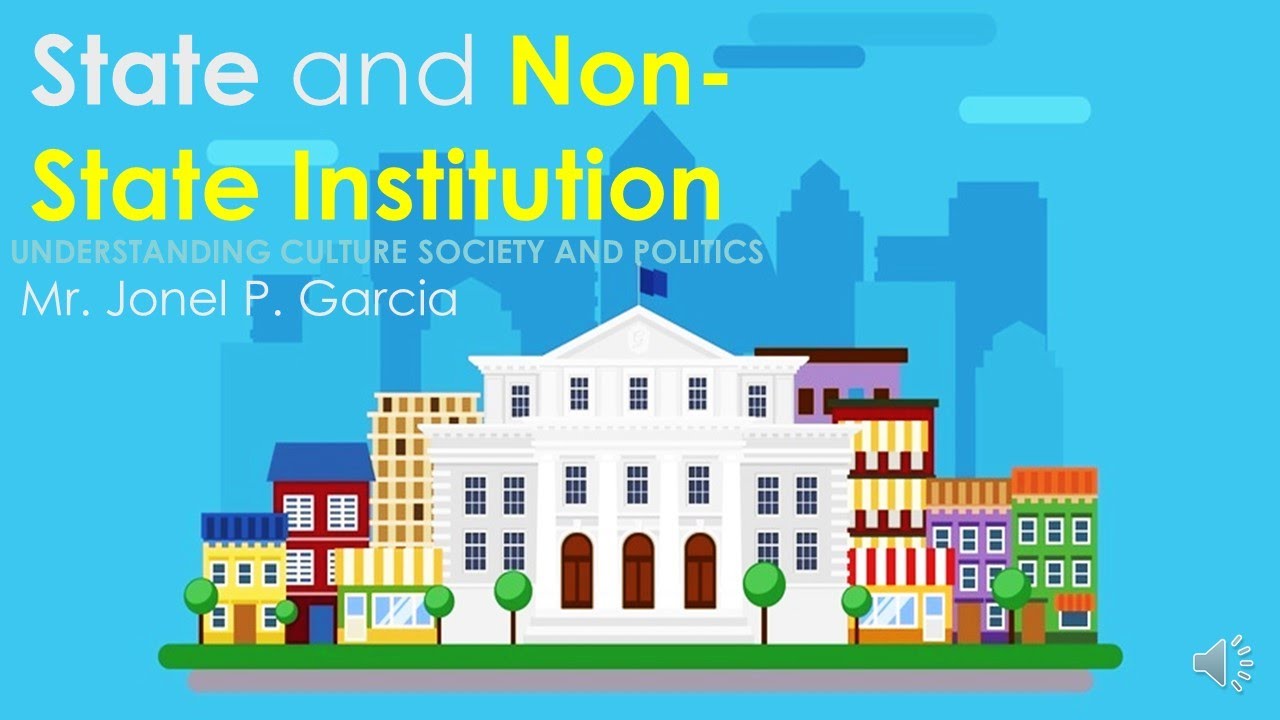UCSP: State and Non-State Institutions
Summary
TLDRThis video explores the role of state and non-state institutions in society, emphasizing their functions and impact on governance and development. It discusses how state institutions like the military and education system serve citizens, while non-state institutions such as banks, cooperatives, and advocacy groups like Greenpeace and Human Rights Watch play crucial roles in promoting social change, economic growth, and environmental protection. The video also highlights the importance of privatization in sectors like telecommunications and transportation. Through engaging examples and activities, the video illustrates how both state and non-state institutions work together to shape societal progress.
Takeaways
- 😀 State institutions are government agencies that work to meet the needs of the people, such as the Department of Education and Armed Forces of the Philippines.
- 😀 Non-state institutions complement the state by addressing gaps and supporting societal needs, especially when the government cannot fully provide for the people.
- 😀 Non-state institutions include banks, corporations, trade unions, cooperatives, civil organizations, and transnational advocacy groups, all of which serve different functions in society.
- 😀 Privatization occurs when state-owned entities, like telecommunications or utilities, are sold to private corporations, which can sometimes spark controversy but are considered necessary for economic efficiency.
- 😀 Non-state institutions like trade unions protect workers' rights and advocate for better compensation and working conditions through negotiations or strikes.
- 😀 Cooperatives are made up of people with common interests, working together to provide affordable access to resources and services.
- 😀 Civil organizations play a crucial role in advocating for the marginalized by raising critical issues with the government, often using mass media to amplify their message.
- 😀 Transnational advocacy groups, such as Greenpeace and Human Rights Watch, influence governments to take action on global and national issues related to the environment and human rights.
- 😀 The Philippine government and non-state institutions work together to meet the diverse needs of society, from education and health care to disaster relief and economic development.
- 😀 The role of private companies in the Philippines has grown significantly, especially in sectors like petroleum, telecommunications, and transportation, where they operate with minimal government supervision.
Q & A
What are the main objectives of the lesson on state and non-state institutions?
-The objectives are to describe the different forms of state and non-state institutions, differentiate their functions, and appraise their roles in relation to personal development and societal progress.
What are examples of state institutions mentioned in the lesson?
-Examples include the Armed Forces of the Philippines (AFP), Department of the Interior and Local Government (DILG), Department of Education (DepEd), Department of Public Works and Highways (DPWH), and Overseas Workers Welfare Administration (OWWA).
How are state and non-state institutions defined in the lesson?
-State institutions are government agencies responsible for delivering basic services and maintaining order, while non-state institutions are organizations outside the government that help address societal needs, such as banks, corporations, trade unions, and civil organizations.
What analogy does the lesson use to explain how the government functions?
-The government is compared to a family, where parents act like leaders who provide and allocate resources, while children play a role by being responsible members who contribute to household duties.
What is the difference between a communist and a democratic form of government according to the lesson?
-In a communist system, the government controls all industries and decision-making, while in a democracy, both government and private entities produce goods and services, giving citizens the freedom to choose.
What is privatization and how has it affected the Philippines?
-Privatization occurs when government agencies or services are transferred to private ownership. In the Philippines, this has led to private control of key industries like telecommunications (PLDT), petroleum (Petron), and water services (MWSS).
What are some examples of non-state institutions discussed in the lesson?
-Examples include banks, corporations, trade unions, cooperatives, development agencies, civil organizations, and transnational advocacy groups.
What is the role of trade unions as non-state institutions?
-Trade unions protect workers’ rights by addressing issues like low wages or lack of benefits and by negotiating with management to improve labor conditions.
How do development agencies contribute to societal progress?
-Development agencies, such as JICA, USAID, and the Asian Development Bank, promote progress by funding infrastructure projects, engaging in policy-making, and supporting economic growth through financial assistance.
What are transnational advocacy groups and what examples were provided?
-Transnational advocacy groups influence governments to take action on global issues. Examples include Greenpeace, which advocates for environmental protection, and Human Rights Watch, which promotes human rights and justice worldwide.
How do civil organizations differ from other non-state institutions?
-Civil organizations operate outside of both government and business sectors, focusing on the welfare of citizens through advocacy, humanitarian aid, and policy influence. Examples include Habitat for Humanity, Ibon Foundation, and Haribon Foundation.
Why are non-state institutions important in a democratic society like the Philippines?
-They complement the government’s efforts by filling gaps in service delivery, providing aid during crises, supporting advocacy for marginalized groups, and fostering development and citizen participation.
Outlines

此内容仅限付费用户访问。 请升级后访问。
立即升级Mindmap

此内容仅限付费用户访问。 请升级后访问。
立即升级Keywords

此内容仅限付费用户访问。 请升级后访问。
立即升级Highlights

此内容仅限付费用户访问。 请升级后访问。
立即升级Transcripts

此内容仅限付费用户访问。 请升级后访问。
立即升级5.0 / 5 (0 votes)






